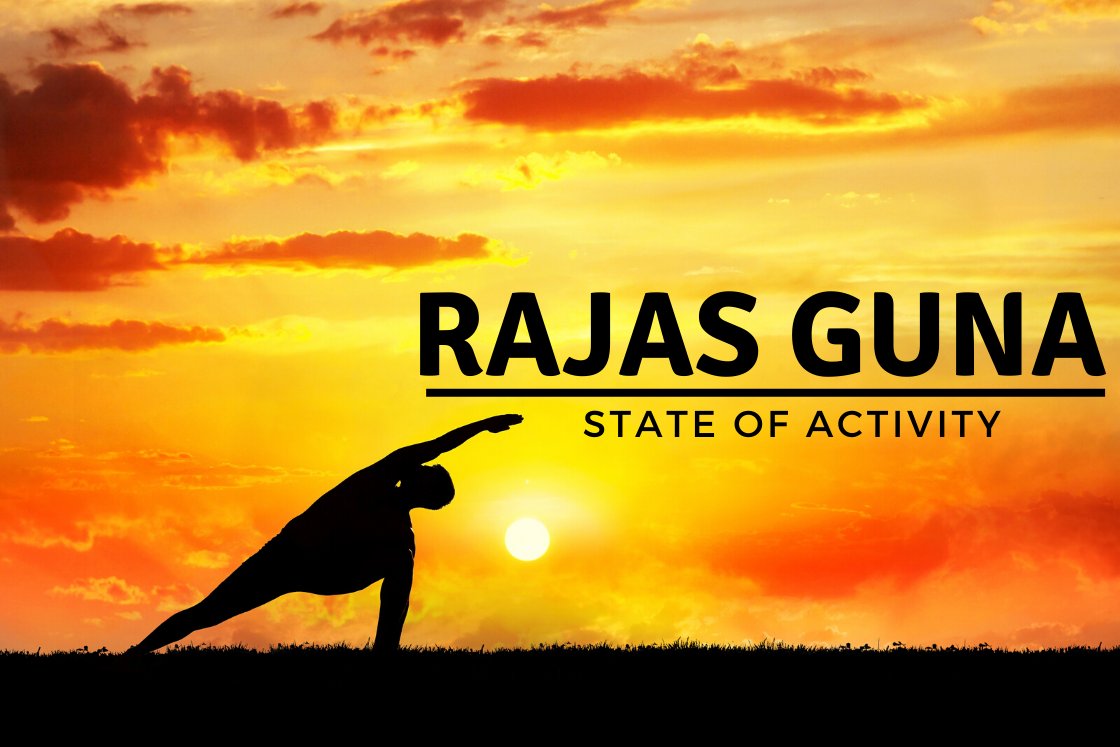
Rajas Guna is the standard in an individual or substance that drives movement, motion, and restlessness. As a result of dominant presence of Rajas within the formation of chitta (the mind-stuff), our ideas are sometimes scattered and the thoughts stays in a wandering state. That is why meditation doesn’t come naturally to many.
Among the many three gunas of nature, Rajas represents a dynamic power between Sattva and Tamas. Whereas Tamas signifies inertia or inactivity, Rajas triggers motion and vitality. Sattva emerges when there’s a good stability between the extremes of Tamas and Rajas.
When Rajas Guna turns into extreme, it results in hyperactivity, overthinking, and anxiousness. Subsequently, managing and decreasing its affect is critical to realize a relaxed, sattvic mind-set.
Nevertheless, earlier than you may stability Rajas Guna, it’s vital to first recognise its indicators inside your self.
Determine your rajas guna

Each individual has all three gunas Sattva, Rajas, and Tamas—inside them. Nevertheless, one guna tends to dominate at a given time. To recognise the affect of Rajas Guna, observe your day by day actions and reactions. Your behaviour displays which guna is presently main your mind-set.
When Rajas Guna is dominant, chances are you’ll discover the next traits:
1. Passionate and impulsive
Individuals influenced by Rajas are sometimes stuffed with needs and pushed by ambition. They’re continuously striving for extra, extra success, extra pleasure, extra recognition. This limitless craving creates restlessness and interior agitation.
In addition they are inclined to act on impulse, making fast choices with out reflection, which may later result in remorse.
2. Defect Seeker (Neglect Good Deeds)
A Rajasic thoughts tends to see faults extra simply than virtues. It usually highlights others’ errors, weaknesses, or unfavorable traits, whereas ignoring their good qualities. This important outlook results in emotions of jealousy, bitterness, and an incapability to forgive.
3. Seeks for brand new
These with sturdy Rajas Guna battle to remain content material with what they’ve. They continuously search new experiences, folks, or materials pleasures to really feel glad. Nevertheless, this craving makes it tough to type lasting relationships or discover true interior peace.
4. Self-centred and seeks consideration
Rajas-dominant people are sometimes self-focused. They might lack compassion for others and care little concerning the happiness of these round them. Their actions are often pushed by the need for identify, fame, or public recognition quite than real goodwill. Even acts of kindness could also be carried out for present.
5. Offended and Fearful
Extra Rajas Guna results in anxiousness, impatience, and emotional instability. Individuals with dominant Rajas usually concern dropping management, standing, or success. They fear about being left behind or outdone, which makes them fast to anger and simply agitated.
Rajas guna in yoga apply

Throughout yoga apply, all three gunas Sattva, Rajas, and Tamas are energetic inside you to various levels.
You could discover Rajas Guna whenever you’re forcing your self deeper right into a posture, even when your physique will not be prepared. Regardless of discomfort or ache, you retain pushing, pushed by the need to “obtain” the complete expression of the pose. This intense effort, usually disconnected from consciousness, displays the stressed and impressive nature of Rajas.
In distinction, whenever you transfer mindfully—staying conscious of your limits and sustaining a wholesome stability between effort and ease you start to expertise a extra easy stream. The posture feels extra pure and balanced. This can be a signal that your thoughts has shifted right into a sattvic state, the place readability, stability, and quietness prevail.
Varieties of rajas guna
In response to yogic philosophy, there are 16 persona sorts based mostly on the three gunas: seven forms of Sattva Guna, six forms of Rajas Guna, and three forms of Tamas Guna.
Six Varieties of Rajas Guna (Primarily based on Behaviour)
1. Asura (Sharing Traits of Asura/villain)
Asura-type Rajasic persons are courageous, aggressive, self-praising, and infrequently converse in poor health of others. They are typically tough-minded, assertive, and typically intimidating in look and behavior.
2. Raksasa (Sharing Traits of Raksasa)
These with Raksasa traits are sometimes stuffed with anger, jealousy, and violence. They get pleasure from non-vegetarian meals, oversleeping, and laziness. Their intolerance and frequent outbursts make them unstable and exhausting to calm.
3. Paisaca (Sharing Traits of Pisaca (evil being)
Individuals with Paisaca traits are gluttonous and pushed by base needs. They are typically unclean, cowardly, and bask in irregular or unhealthy diets. Their behaviour usually displays decrease instincts and lack of management.
4. Sarpa (Sharing Traits of Snake)
Sarpa-type people are courageous in anger however cowardly when calm. They’ve sharp reactions and a lazy nature. Though not gluttonous, they’re usually tense and anxious.
5. Praita (Sharing Traits of Departed Spirit)
These persons are excessively grasping, troublesome, and interact in backbiting. They’ve an insatiable urge for food for meals and lack self-discipline of their day by day habits. Irregularity and dysfunction are widespread of their way of life.
6. Sakuna (Sharing Traits of Sakuni-Chicken)
Sakuna-type Rajasic people are hooked up to pleasures and meals. They’re usually untidy, disorganised, and emotionally unstable. Their minds continuously leap from one need to a different, very like a stressed fowl.
Easy methods to scale back rajas guna

Though Rajas Guna supplies vitality and drive, an excessive amount of of it results in restlessness, anxiousness, and imbalance. Lowering this guna is crucial to develop a Sattvic (peaceable and clear) mind-set.
Listed below are some sensible methods to scale back the dominance of Rajas Guna:
1. Working towards Restorative or Counter Pose
In your yoga apply, embrace restorative poses to calm the nervous system and scale back rajasic vitality. After intense backbends or ahead bends, observe up with counterposes to convey the physique into stability.
2. Cooling down by Pranayama
Breathwork has a strong impact on the thoughts. To scale back Rajas, practise cooling pranayama similar to:
3. Bettering Consuming Habits
What you eat immediately influences your psychological state. Meals which might be spicy, oily, bitter, bitter, or overly salty are rajasic and enhance restlessness.
To scale back Rajas:
- Keep away from fried, processed, or spicy meals.
- Eat mild, contemporary, and sattvic meals.
- Embrace extra fruits, greens, complete grains, and plant-based proteins in your food plan.
4. Give Your Senses Soothing Vibes
Your atmosphere impacts your mind-set. Loud, violent, or chaotic visuals and sounds enhance rajasic tendencies.
Select calming music, pure visuals, and optimistic content material to appease your senses. Making a peaceable house helps a extra sattvic mindset
5. Sleep Adequately
Lack of sleep makes the thoughts irritable and hyperactive, whereas an excessive amount of sleep results in dullness.
Intention for balanced, high quality sleep to present your physique and thoughts time to relaxation, get well, and regulate emotional vitality.
6. Spend Time with Your self
grāmo rājasa ucyate
“Residence in village or city is within the Rajas Guna.” – Srimad Bhagavatam 11.25.25
Srimad Bhagavatam says, dwelling away from nature is a attribute of Rajas Guna. The busy life, away from nature, will increase the qualities of this Guna. Subsequently, take a break and provides a while to your self, within the lap of nature.
7. Suppose for Different’s Wellbeing
rājasaṁ phala-saṅkalpaṁ
“Work carried out with a need to benefit from the outcomes is within the Rajas Guna.”- Srimad Bhagavatam 11.25.23
The actions carried out selfishly are Rajas. So, to stability it, attempt to carry out actions enthusiastic about others. Additionally, attempt to not be self-centered and egocentric.
You may study by karma yoga easy methods to do selflessly work. It can enhance the sense of satisfaction and pleasure inside you, which leads towards sattva.
Conclusion
As you start to scale back Rajas Guna, keep in mind to keep away from slipping into Tamas (inactivity or dullness). The aim is to domesticate Sattva, which brings peace, readability, and stability.
To really stability Rajas Guna, you’ll want to regulate your food plan, way of life, and day by day habits. It could really feel difficult at first, particularly for those who’re used to fast-paced or stimulating routines. However with endurance, consistency, and interior dedication, you’ll progressively really feel a shift.
Over time, you’ll discover improved calmness, readability of thought, and a deeper sense of well-being.
